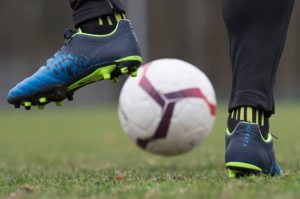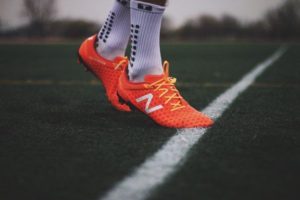The history of boots dates back to the time of the English monarch Henry VIII: he was the first to think about special shoes for ball games. Bulky and heavy at first, the boots have evolved into comfortable shoes, available in many models. Which one should I choose?
What types of football boots are there?
Focusing on the specific conditions of the game, the sports industry has developed numerous types of football shoes:
 Soft Ground: designed for soft surfaces, remains a favorite of goalkeepers, equipped with six to eight studs (possibly equipped with metal “caps”), and is characterized by an even distribution of the load on the limb. SG is not recommended for children under 16 years of age: the arch of the foot is not yet strong;
Soft Ground: designed for soft surfaces, remains a favorite of goalkeepers, equipped with six to eight studs (possibly equipped with metal “caps”), and is characterized by an even distribution of the load on the limb. SG is not recommended for children under 16 years of age: the arch of the foot is not yet strong;- Firm Ground: suitable for synthetic and grass surfaces, allows you to reach maximum speed;
- Hard Ground is also suitable for different types of surfaces, equipped with thirteen rounded spikes;
- Soft Ground Pro: most world-famous professional teams are equipped with them; no surface other than grass is suitable for them;
- Futsal or Indoor Cleats: designed for the gym, have no spikes, have a lightweight upper and a flexible sole.
Which company should you prefer? Original or replica?
Of all the manufacturers, including those with a worldwide reputation, the leaders remain the mighty three:
 Nike;
Nike;- Adidas;
- Puma.
Being equal participants in the sportswear and footwear market, companies have specific assortment features. Thus, Puma focuses on the production of football boots for games in open stadiums, while Nike preferred to establish mass production of futsal shoes.
However, the price of their products makes you wonder: isn’t it easier to buy a replica, which is sometimes indistinguishable from the original by eye? Saving double or triple is tempting, and a copy of a world-famous brand may also demonstrate resistance to an intense sports regime.
But the replica only copies the external similarity of branded items, but pseudo-adidas and pseudo-puma will not be able to reproduce their technological highlights. Reputable companies have a whole staff of developers working tirelessly to improve the comfort of equipment for champions. Replica manufacturers do not have such resources.
Important! A not too zealous pursuit of fashion will help you get branded shoes without going broke: products from previous seasons will cost much less.
Criteria for choosing quality shoes
Having decided on the model and brand, let’s take a closer look at the details of the pair we are choosing.
Upper material
It could be:
 Being the best of materials, Leather, breathable and soft, requires, however, attention when determining the size. The material will stretch quickly, so such a shoe should fit quite tightly on the foot.The best and most expensive remains the kangaroo; veal will be coarser, but cheaper.
Being the best of materials, Leather, breathable and soft, requires, however, attention when determining the size. The material will stretch quickly, so such a shoe should fit quite tightly on the foot.The best and most expensive remains the kangaroo; veal will be coarser, but cheaper.- Leatherette, which does not allow moisture to pass through, is ideal for wet weather. However, it requires hygroscopic socks for known physiological reasons.
- Suede and its substitutes are good for their ability to retain their shape.
- Textiles are great for futsal and absolutely unsuitable for the street. The exception is dry summer weather.
Important! When choosing synthetic shoes, you need to remember about their inability to stretch. It is recommended to take half a size larger, as athletes' feet often swell.
Sole
Made from:
- rubber;
- polyurethane.
The latter is more suitable both in terms of comfort and protective properties. And it doesn’t stain the floor like rubber!
Insole
 Of all the sports “tricks” like weights for a more powerful blow or inserts with silver for an antibacterial effect, only the instep supports deserve real attention. They are made from individual casts, taking into account all orthopedic nuances. The most advanced option may cost more than a car of a lower class.
Of all the sports “tricks” like weights for a more powerful blow or inserts with silver for an antibacterial effect, only the instep supports deserve real attention. They are made from individual casts, taking into account all orthopedic nuances. The most advanced option may cost more than a car of a lower class.
There are also economy class options that protect the player’s legs from problems with the musculoskeletal system. And Andrei Arshavin does without insoles at all, throwing them out of any pair of boots.
Lacing
 Lacing your shoes correctly before training and matches is important to prevent sports injury. However, Adidas has already introduced laceless models to the market. Still, lace-up shoes are the priority for now. Two options:
Lacing your shoes correctly before training and matches is important to prevent sports injury. However, Adidas has already introduced laceless models to the market. Still, lace-up shoes are the priority for now. Two options:
- in the center;
- on the side.
The latter is designed to make the shot more technical due to the smoothness of the top of the boot and a better feel for the ball. However, there is an opinion that this is nothing more than a marketing ploy. A For young athletes who continue to grow, this type of lacing is completely contraindicated in order to avoid deformation of the leg bones.
Choosing children's boots
 Children's boots differ from adults in shape and increased number of spikes. You can opt for the universal Multi Ground, equipped with twenty-four studs, if you are confident in the hardness and dryness of the playing field. AST and TURF are ideal for grass.
Children's boots differ from adults in shape and increased number of spikes. You can opt for the universal Multi Ground, equipped with twenty-four studs, if you are confident in the hardness and dryness of the playing field. AST and TURF are ideal for grass.
Important! TURF is characterized by increased adhesion! Going out in synthetics in them is fraught with injury.
For playing on synthetic surfaces, the MSR marking is optimal: the round shape of the studs provides comfort, relieving excess load from the foot. Also suitable for hard lawns.
Gravel and crushed stone fields tighten the requirements for boots. Very Hard Ground can completely satisfy them: flat studs will allow the young athlete to rush around the field faster. They remain the most suitable equipment option for winter football.
When - with thorns, and when - centipedes?
 The choice depends on the coating: natural or synthetic, dry or wet. The studs are designed to provide maximum grip on the field surface, but the maximum should not be excessive!
The choice depends on the coating: natural or synthetic, dry or wet. The studs are designed to provide maximum grip on the field surface, but the maximum should not be excessive!
Firm Ground remains a universal option – Suitable for both grass and synthetic fields. Quality grass fields that are wet from rain require a Soft Ground model. Hard Ground are suitable for playing on a hard grass field.
“Centipedes” or TURF, equipped with an increased number of studs, are far ahead of classic boots in terms of comfort due to the even distribution of the load. But, the more spikes, the higher the degree of adhesion. Therefore, “turf” is excellent for lawns and dangerous on an artificial field!
How do you know if the boots are chosen correctly?
 The criterion for shoes remains their comfort.. The case of boots is special: physical activity will add volume to the leg during training due to swelling. If it was quite comfortable in the store, but not so much on the field, it means that the choice was unsuccessful. The wear resistance of boots is a matter of course: they should not fall apart before they are put into use.
The criterion for shoes remains their comfort.. The case of boots is special: physical activity will add volume to the leg during training due to swelling. If it was quite comfortable in the store, but not so much on the field, it means that the choice was unsuccessful. The wear resistance of boots is a matter of course: they should not fall apart before they are put into use.
Important! High-quality boots should last at least six months of intensive wear.
That's why You need to pay maximum attention at the fitting stage. The wrong choice will destroy the merits of the best boots!
 You need to be especially careful when choosing shoes ordered online.. Shoe manufacturers have simplified the task of determining size by agreeing on a single size grid for all. If these are not the first boots, you can look inside one of the shoes, find a summary table of sizes there and, focusing on the country of origin, find the right one.
You need to be especially careful when choosing shoes ordered online.. Shoe manufacturers have simplified the task of determining size by agreeing on a single size grid for all. If these are not the first boots, you can look inside one of the shoes, find a summary table of sizes there and, focusing on the country of origin, find the right one.
For beginners, it’s better to visit the company store of the chosen brand, find a model similar to the one you like, and try it on. Then feel free to order “your” model: the size grid within one brand is the same.
By sending someone else to pick up the boots instead of yourself, you can resort to the antediluvian method of measuring the foot. The outline of the leg will help you navigate the width of the product.
And yet, the best way to select your own shoes is to thoroughly try on pair after pair. Until the leg gives the signal: “Mine!”


 Soft Ground: designed for soft surfaces, remains a favorite of goalkeepers, equipped with six to eight studs (possibly equipped with metal “caps”), and is characterized by an even distribution of the load on the limb. SG is not recommended for children under 16 years of age: the arch of the foot is not yet strong;
Soft Ground: designed for soft surfaces, remains a favorite of goalkeepers, equipped with six to eight studs (possibly equipped with metal “caps”), and is characterized by an even distribution of the load on the limb. SG is not recommended for children under 16 years of age: the arch of the foot is not yet strong; Nike;
Nike; Being the best of materials, Leather, breathable and soft, requires, however, attention when determining the size. The material will stretch quickly, so such a shoe should fit quite tightly on the foot.The best and most expensive remains the kangaroo; veal will be coarser, but cheaper.
Being the best of materials, Leather, breathable and soft, requires, however, attention when determining the size. The material will stretch quickly, so such a shoe should fit quite tightly on the foot.The best and most expensive remains the kangaroo; veal will be coarser, but cheaper. 0
0





